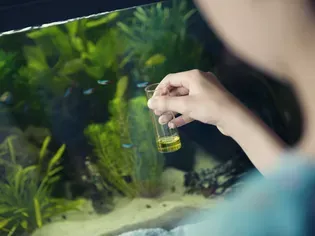How to Treat Ich on Freshwater Fish
Updated on 04/26/24

Headline: Conquer Ich: A Comprehensive Guide to Treating Freshwater Fish
Introduction:
Ich, a highly contagious parasitic infection, can strike terror into the hearts of freshwater fish keepers. Characterized by tiny white spots on the body and fins, this condition can rapidly spread and decimate entire populations if left untreated. Don't fret! With the right knowledge and swift action, you can effectively combat ich and restore the health of your aquatic friends. This extensive guide will empower you with proven strategies and insights to treat ich successfully.
Understanding the Ich Parasite:
Ichthyophthirius multifiliis, the culprit behind ich, is a unicellular protozoan parasite. It thrives in freshwater environments and can infect a wide range of fish species. Its life cycle involves three stages:
* Trophont: The actively feeding stage, visible as white spots on the fish.
* Tomont: The reproductive stage, where the parasite forms cysts on the aquarium substrate.
* Theront: The infective stage, which swims freely in the water and attaches to fish.
Symptoms and Diagnosis of Ich:
Identifying ich is crucial for prompt treatment. Classic symptoms include:
* White spots (1-2 mm) scattered on the body, fins, and gills.
* Flashing: Fish may rub against objects to dislodge the parasites.
* Clamping fins: Fish may hold their fins close to their bodies due to irritation.
* Lethargy: Infected fish often appear sluggish and lethargic.
Treatment Options:
Various methods can be employed to treat ich effectively:
1. Elevated Temperature:
* Increase the water temperature to 82-86°F (28-30°C) for several days.
* This accelerated parasite development, causing the trophont stage to detach from the fish.
* Avoid raising the temperature too quickly, as it can stress the fish.
2. Medications:
* Use over-the-counter medications specifically formulated for ich treatment.
* Follow the manufacturer's instructions carefully, as some medications may require multiple treatments.
* Examples include malachite green, formalin, and metronidazole.
3. Salt Baths:
* Dissolve non-iodized salt in a separate container at a ratio of 1-3 teaspoons per gallon of water.
* Dip the infected fish in the salt bath for 10-15 minutes.
* Repeat the process daily until the ich spots disappear.
4. UV Sterilization:
* UV sterilizers emit ultraviolet light that kills bacteria and parasites in the water.
* Run the UV sterilizer continuously for several weeks to eliminate theronts and break the ich life cycle.
5. Vacuuming and Water Changes:
* Vacuum the substrate thoroughly to remove tomont cysts.
* Perform regular partial water changes (25-50%) to reduce the parasite load in the water.
Prevention Tips:
Prevention is always better than cure. Follow these tips to minimize the risk of ich infection:
* Quarantine new fish for 2-4 weeks before introducing them to the main tank.
* Regularly clean the aquarium, including the substrate and filter.
* Avoid overstocking the tank, as overcrowding can stress the fish and make them more susceptible to infections.
* Feed the fish a balanced and nutritious diet to boost their immune system.
Case Study: Ich Treatment Success
A community tank of guppies and neon tetras was recently diagnosed with ich. The following steps were taken to treat the infection effectively:
* The water temperature was raised to 84°F (29°C).
* Malachite green medication was administered according to the manufacturer's instructions.
* The substrate was vacuumed daily.
* Partial water changes (30%) were performed every other day.
Within a week, the ich spots began to diminish, and the fish showed signs of recovery. The treatment was continued for another week to ensure the elimination of all parasites. The fish made a full recovery and remained healthy in the tank without any recurrence of ich.
Conclusion:
Treating ich on freshwater fish requires a comprehensive approach that involves identification, treatment, and prevention. By understanding the parasite's life cycle, employing effective treatment methods, and implementing preventive measures, you can effectively combat this common infection. Remember, prompt action is crucial to minimize fish mortality and ensure the well-being of your aquatic community. With the knowledge provided in this guide, you can confidently conquer ich and maintain a thriving freshwater aquarium teeming with healthy and vibrant fish.
Explore More Pets

Freshwater Aquarium Filters
How to Deal With Cloudy Aquarium Water

Saltwater Aquarium Filters
How Do You Remove Chloramines From Tap Water?

Freshwater Aquariums & Habitat
Can I Keep My Koi Fish Inside?

Saltwater Aquariums & Habitat
14 Best Floating Plants for Your Aquarium

Saltwater Fish Health
Fin Rot in Aquarium Fish

Freshwater Aquarium Filters
How to Do Aquarium Water Changes

Saltwater Fish Health
How Do Fish Get Parasites?

Freshwater Aquarium Filters
Aquarium Water Parameters to Control for Healthy Fish